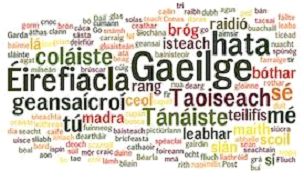By Sarah-Claire Jordan

There’s probably no need to learn Irish, also known as Gaelic or Irish Gaelic, if you plan on visiting or even moving to Ireland. If you want to truly get to know Irish culture better, however, and connect more with its history, you should at least learn about the language that is still spoken as a native language by about 150,000 people in Ireland, and as a second language by some one million more.
Irish is an Indo-European language and a member of the Goidelic or Gaelic language family, which in turn belongs to the Celtic language branch. Up until the 1600s, it was the only language spoken in the nation of Ireland. Later, in the 1800s, certain issues led many native speakers to move to other countries, namely the Potato Famine. This led to an increase in English use, and nowadays there are only small communities left that speak Irish exclusively, known as “Gaeltacht”.
It was finally adopted as an official language in Ireland, along with English, in 1922 when the Republic of Ireland was established. As a result, any school funded by the government had to include it as part of the curriculum. Nowadays, there are schools that are taught entirely in Gaelic, called “gaelscoileanna”. There are other examples of what could be seen as a revival of the language, such as radio stations, literature, theater, and much more. The gaelscoileanna are definitely contributing to the number of speakers, but more and more young people are opting to use English instead of their native tongue.
In terms of dialects, there are more or less three main ones. Munster, Connacht, and Ulster are the names given to these dialects, which correspond to the provinces they are mainly spoken in (Munster, Connacht, and Ulster). There are also some urban varieties of the language, which are sometimes referred to as “school Irish”. There used to be a group of dialects called Leinster as well, but they are now extinct.
Besides the three main dialects, there is also one standard dialect which is taught in schools. It is known as “An Caighdeán Oifigiúil” meaning “The Official Standard” and often called simply “An Caighdeán”. It was first developed in the 1950s and 1960s with two main purposes: to make spelling simpler and to create a written form that was mutually intelligible for all speakers of the Irish language. The creation of a standard dialect also made it easier to learn as a second language. An Caighdeán tends to show heavy Connacht/Western Irish influence.
The original alphabet that was used to write Irish as well as other Celtic languages is called the ogham alphabet. It had 25 letters, and was used up until the introduction of the Latin alphabet in the 5th century BC. The letters were made up of strokes, either perpendicular or angled, that were combined with others and sometimes crossed. The introduction of the Latin alphabet made for some difficult issues regarding how to spell certain words with a totally different type of letter.



